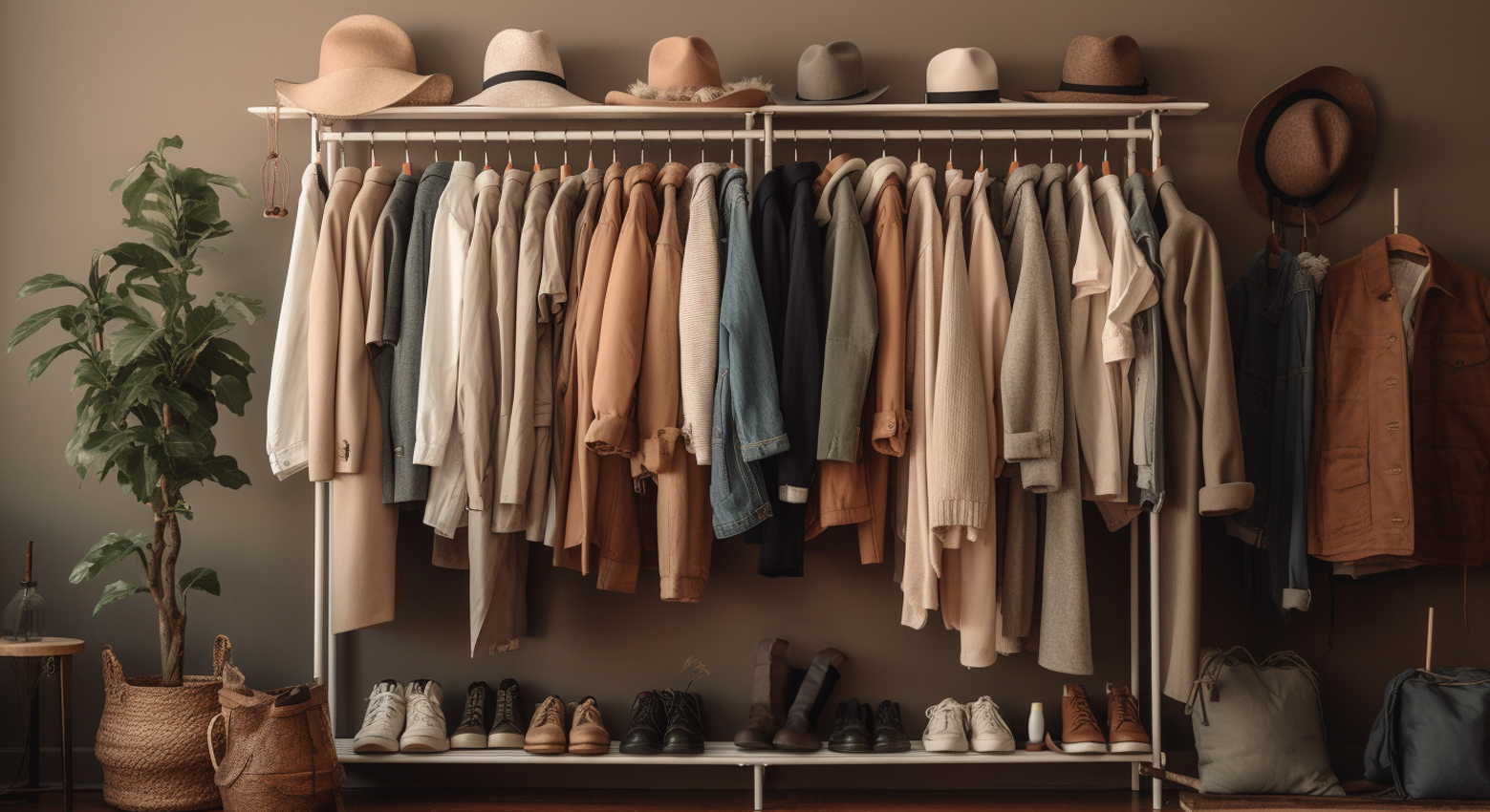Building a Sustainable Wardrobe on a Budget
Hey there! Are you passionate about sustainable fashion but worried about the potential strain on your wallet? Fear not! In this blog article, we’ll guide you through the art of building a sustainable wardrobe on a budget. Being eco-friendly and fashion-forward doesn’t have to break the bank.
With a little creativity, strategic shopping, and some handy tips, you can create a stylish and sustainable wardrobe that aligns with your values without sacrificing your financial well-being.
So, let’s dive right in and discover how to rock an eco-friendly wardrobe on a shoestring!
Assess and Declutter
Before embarking on building a sustainable wardrobe on a budget, it’s important to assess your current clothing inventory and declutter. Take the time to go through your wardrobe and evaluate each item’s sustainability and versatility.
Ask yourself questions like: How often do I wear this? Can it be styled in different ways? Does it align with my values and personal style? This process will help you identify which pieces can be repurposed, donated, or sold.
By decluttering, you create space in your wardrobe for new sustainable additions while being mindful of minimizing waste. Consider organizing clothing swaps with friends or within your community to exchange items you no longer wear for something new-to-you. Donating clothes to local charities or second-hand stores also gives them a chance to find new homes and extend their lifespan.
- Take inventory of your current wardrobe and assess the sustainability of each item.
- Determine which pieces can be repurposed, donated, or sold.
- Consider the versatility of each item and whether it aligns with your style and values.
Define Your Style and Capsule Wardrobe
Defining your personal style is key to building a sustainable wardrobe on a budget. Take some time to explore different fashion aesthetics and identify what resonates with you. Consider factors like colors, patterns, and silhouettes that make you feel confident and comfortable. This will help guide your purchasing decisions and ensure that the items you choose are truly reflective of your style.
Creating a capsule wardrobe is an effective strategy for building a sustainable wardrobe on a budget. A capsule wardrobe consists of versatile, timeless pieces that can be mixed and matched to create multiple outfits. Start by selecting a color palette that complements your skin tone and allows for easy coordination.
Focus on essential items like a well-fitted pair of jeans, a versatile blazer, and classic tops. These foundational pieces will form the backbone of your capsule wardrobe, making it easier to put together stylish outfits without needing a large quantity of clothes.
- Experiment with different styles and identify what resonates with you.
- Select a color palette that complements your skin tone and can be easily mixed and matched.
- Focus on timeless essentials such as a white shirt, black trousers, and a versatile blazer to form the foundation of your capsule wardrobe.
Thrift and Second-Hand Shopping
Thrift and second-hand shopping are fantastic ways to build a sustainable wardrobe on a budget. Exploring thrift stores, consignment shops, and online platforms dedicated to pre-loved clothing can lead to hidden treasures. Not only will you find unique and one-of-a-kind pieces with character, but you’ll also save money and contribute to reducing the demand for new clothing production.
When thrift shopping, take your time and be open to exploring different sections and sizes. Sometimes, the best finds can be discovered in unexpected places. Inspect items carefully for quality, checking for any signs of wear or damage. Focus on finding garments that are well-made and fit you properly. Thrift shopping requires patience, but the rewards are worth it when you uncover unique pieces that align with your style.
- Explore local thrift stores, consignment shops, and online platforms for affordable, pre-loved clothing.
- Look for high-quality pieces that are in good condition and suit your personal style.
- Be patient and persistent, as finding gems in thrift stores may require some digging.
Embrace Clothing Swaps and Borrowing
Organizing clothing swaps with friends, family, or within your community is an excellent way to build a sustainable wardrobe without spending money. Clothing swaps allow you to trade items you no longer wear for new-to-you pieces. They are not only environmentally friendly but also a fun social activity.
Invite your friends to bring their unwanted clothing items and gather in a central location. Set some ground rules, such as the number of items each person can bring, and encourage everyone to bring clean and good-quality clothes. During the swap, take turns browsing and selecting items that catch your eye. It’s a win-win situation where you can declutter your closet and refresh your wardrobe at no cost.
In addition to clothing swaps, consider borrowing clothes from friends or family for special occasions. If you have a wedding, party, or other events on the horizon, borrowing a dress or suit can save you money and prevent the need for a one-time outfit purchase. Just be sure to return borrowed items promptly and in good condition.
- Organize clothing swaps with friends, family, or local communities to exchange items you no longer wear.
- Borrow clothes from friends for special occasions or consider renting for events.
- Build a network of like-minded individuals who are open to sharing and borrowing clothes.
Prioritize Quality and Versatility
Investing in high-quality garments is a crucial aspect of building a sustainable wardrobe on a budget. Quality pieces not only last longer but also tend to be made from sustainable materials and ethical manufacturing processes. When shopping, take the time to assess the craftsmanship of a garment, paying attention to details like stitching, seams, and fabric quality.
Prioritize versatile pieces that can be dressed up or down for various occasions. Look for classic designs that transcend trends and can be mixed and matched with other items in your wardrobe. A well-fitted white shirt, a pair of black trousers, and a little black dress are examples of versatile wardrobe essentials that can be styled in numerous ways. Investing in quality basics will provide a solid foundation for your sustainable wardrobe and reduce the need for constant purchases.
- Invest in well-made garments that will withstand frequent wear and washing.
- Look for timeless designs that can be easily dressed up or down for various occasions.
- Consider the cost per wear when evaluating the price of an item to determine its long-term value.
Focus on Sustainable Fabrics
Choosing clothing made from sustainable fabrics is another important aspect of building a sustainable wardrobe. Opt for materials that have minimal environmental impact, such as organic cotton, hemp, linen, and recycled fibers. These fabrics are produced using fewer chemicals, less water, and lower energy consumption compared to conventional materials.
When shopping, check clothing labels for certifications such as Global Organic Textile Standard (GOTS) or Oeko-Tex Standard 100, which ensure the materials meet specific sustainability criteria. By prioritizing sustainable fabrics, you contribute to a cleaner and greener fashion industry while enjoying comfortable and durable clothing.
- Research and choose fabrics made from organic cotton, hemp, linen, or recycled fibers.
- Check clothing labels for certifications such as Global Organic Textile Standard (GOTS) or Oeko-Tex Standard 100.
- Opt for natural fibers that are biodegradable and have a lower environmental impact.
DIY and Upcycling Projects
Unleash your creativity by engaging in do-it-yourself (DIY) projects and upcycling old clothing. Transform tired garments into unique pieces that reflect your personal style. Whether it’s adding embellishments, altering the fit, or completely repurposing them, DIY and upcycling projects allow you to breathe new life into your wardrobe.
Browse through online tutorials and resources to learn new techniques and get inspiration for your projects. For example, you can turn a larger shirt into a trendy crop top or transform a pair of jeans into fashionable shorts. By repurposing what you already have, you not only save money but also reduce waste and contribute to a more sustainable fashion industry.
- Get creative and repurpose old clothing through sewing, embellishing, or altering.
- Turn a larger shirt into a trendy crop top or transform jeans into shorts.
- Look for online tutorials or attend workshops to learn new upcycling techniques and ideas.
Renting and Borrowing Services
Renting and borrowing clothing has become a popular trend in the world of sustainable fashion. If you have a special occasion coming up or want to try out trendy pieces without committing to a purchase, clothing rental services can be a great option. Look for platforms that offer a wide selection of high-quality garments, including formal dresses, designer accessories, and statement pieces. By renting instead of buying, you reduce your environmental impact and save money.
In addition to clothing rental services, borrowing platforms have emerged, allowing you to borrow clothes from others within your community. This not only expands your wardrobe options but also fosters a sense of community and encourages sharing. You can borrow items for a specific period, whether it’s a dress for a wedding or a cozy sweater for a winter getaway. It’s a cost-effective way to refresh your wardrobe and access new styles without accumulating more items.
Consider subscribing to fashion rental or borrowing services that offer a rotating wardrobe for a fixed monthly fee. This way, you can regularly update your looks without the need for constant purchases. Keep in mind that proper care and timely returns are essential to maintain a positive experience with these services.
- Consider using clothing rental services for special occasions or trendy pieces.
- Explore borrowing platforms where you can borrow clothes from others for a specific period.
- Utilize subscription services that offer a rotating wardrobe for a fixed monthly fee.
Sustainable Accessories
Building a sustainable wardrobe goes beyond clothing; it includes accessories as well. When choosing accessories, look for brands that prioritize sustainability, ethical practices, and eco-friendly materials. Sustainable shoes, for example, may be made from recycled materials or produced using low-impact processes. Ethical bags are often crafted by artisans who receive fair wages and work in safe conditions. Conscious jewelry may use recycled metals or ethically sourced gemstones.
Investing in sustainable accessories ensures that your entire outfit aligns with your eco-friendly values. Choose versatile pieces that can be paired with multiple outfits, maximizing their use and minimizing the need for excessive purchases. A pair of timeless, ethically made shoes can complement both casual and formal looks, while an eco-friendly bag can elevate any ensemble. Opt for classic designs that will withstand the test of time, reducing the temptation to constantly follow fast-fashion trends.
- Invest in sustainable accessories such as ethically made shoes, bags, and jewelry.
- Look for brands that prioritize eco-friendly materials and transparent supply chains.
- Opt for versatile accessories that can be paired with multiple outfits, maximizing their use.
Mindful Care and Repair
To truly build a sustainable wardrobe, it’s essential to practice mindful care and repair of your clothing. By extending the lifespan of your garments, you reduce the need for replacements and contribute to a more sustainable fashion industry. Proper care starts with following care instructions provided on clothing labels. Wash your clothes on gentle cycles using eco-friendly detergents, and opt for air-drying whenever possible. These simple steps can significantly prolong the life of your clothing and preserve their quality.
Learning basic sewing skills can also be incredibly useful for small repairs and alterations. Mend small tears, replace missing buttons, or adjust the fit of a garment to make it feel like new again. There are numerous online tutorials and resources available to help you learn the basics of sewing. For more complex repairs or alterations that require professional expertise, consider using a trusted tailor or seamstress who specializes in sustainable fashion.
- Extend the lifespan of your clothing by following proper care instructions, such as washing on gentle cycles and air-drying.
- Learn basic sewing skills to mend small tears or replace buttons.
- Utilize professional repair services for more complex repairs or alterations.
End Words
Building a sustainable wardrobe on a budget is entirely achievable with a bit of planning, resourcefulness, and an eye for quality. By assessing your current wardrobe, defining your style, and embracing second-hand shopping, you’ll discover hidden gems while reducing your environmental footprint. Prioritizing quality, versatility, and sustainable fabrics ensures that your wardrobe is built to last and aligns with your eco-friendly values. So, embrace your creative spirit, explore thrift stores, and let your sustainable fashion journey begin. With a little effort and a whole lot of style, you can build a budget-friendly wardrobe that leaves a positive impact on the planet.
By incorporating the tips, we shared in this article, into your sustainable wardrobe-building journey, you can make conscious choices that are both budget-friendly and environmentally responsible.
Building a sustainable wardrobe is a continuous process, so remember to be patient, creative, and enjoy the adventure of discovering new ways to express your style while protecting the planet.
Happy Shopping!




